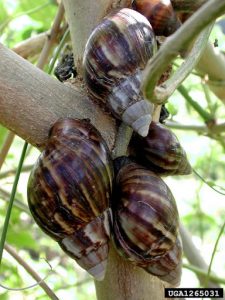The Florida Department of Agriculture and Consumer Services Division of Plant Industry and the USDA have officially announced the eradication of giant African land snails (GALS) from the state of Florida.

Of interest to note, this is the second time giant African land snails have been eradicated from the state. With over 300,000 surveys, 168,539 collected snail specimens, and 4.2 million pounds of debris removed over the last 11 years.
It is thought that the Giant African land snail (Lissachatina fulica) was first introduced to Florida in 1966, when a child brought three snails to keep as pets into south Florida from a recent trip to Hawaii. As is the fate of many exotic pets, these snails were eventually released into the wild. Some time later, these snails began breeding and laying eggs, where their numbers quickly expanded to over 18,000 adults. Removal and quarantine efforts were swift and efficacious, later reporting it’s eradication in 1975. Still, these pesky snails were observed yet again in 2011. While the exact cause of the reintroduction of the giant African land snails is not clear, some suggest that they were brought back into the state by religious groups for use in healing rituals and others believe that they may be hitchhiking a ride on cargo ships.

Considered some of the most damaging snails in the world, these pests feed on over 500 host plants including many prized fruits and vegetables. When not satiated by plant material, these snails may begin munching on paint and stucco on houses. In addition to this damage, these snails may also carry parasites which cause diseases in humans and livestock.
Growing up to 8 inches in length and 5 inches in diameter, each snail exhibits both male and female reproductive organs. Following mating, they are capable of laying anywhere from 100-500 eggs, and can quickly reproduce without having to engage in mating again.
Without a reported sighting since 2017, this exciting official declaration was made last week.
Source: UF/IFAS Pest Alert



